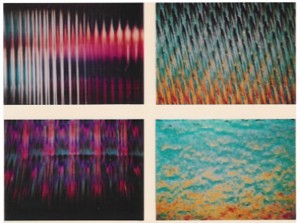This evening I watched, at a friend’s house, Jordan Belson’s, Phenomena, a 6 minute 16mm colour film he completed in 1965 with fairly primitive equipment. Gene Youngblood, who devoted an entire chapter of his book “Expanded Cinema” [1] to ‘The Cosmic Cinema of Jordan Belson’ wrote:
The essence of cinema is precisely “dynamic movement of form and color,” and their relation to sound. In this respect Belson is the purest of all filmmakers. With few exceptions his work is not “abstract.” Like the films of Len Lye, Hans Richter, Oskar Fischinger, and the Whitneys, it is concrete. Although a wide variety of meaning inevitably is abstracted from them, and although they do hold quite specific implications for Belson personally, the films remain concrete, objective experiences of kinaesthetic and optical dynamism.
Indeed, the fields of colour possess a three dimensional, nearly tangible sense of texture.
There do not seem to be many of Belson’s works available on YouTube. It seems that he felt the quality of streamed video did not do justice to his films. But it is unfortunate that it is so difficult to see his work. I have a DVD with some of the films. Anyone (in the zemi) interested in seeing the DVD, please let me know.
[1] Gene Youngblood, Expanded Cinema, New York, E.P. Dutton & Co. (1970).
Youngblood’s classic book is available online as a PDF file at the Steina and Woody Vasulka online archive of experimental video art. The wikipedia contains an outline of the book.
I recommend having a quick look at the Wikipedia entry about Jordan Belson , then proceeding to the Jordan Belson pages at Center for Visual Music as well as Part III of Gene Youngblood’s book, for more detailed and definitive information.

